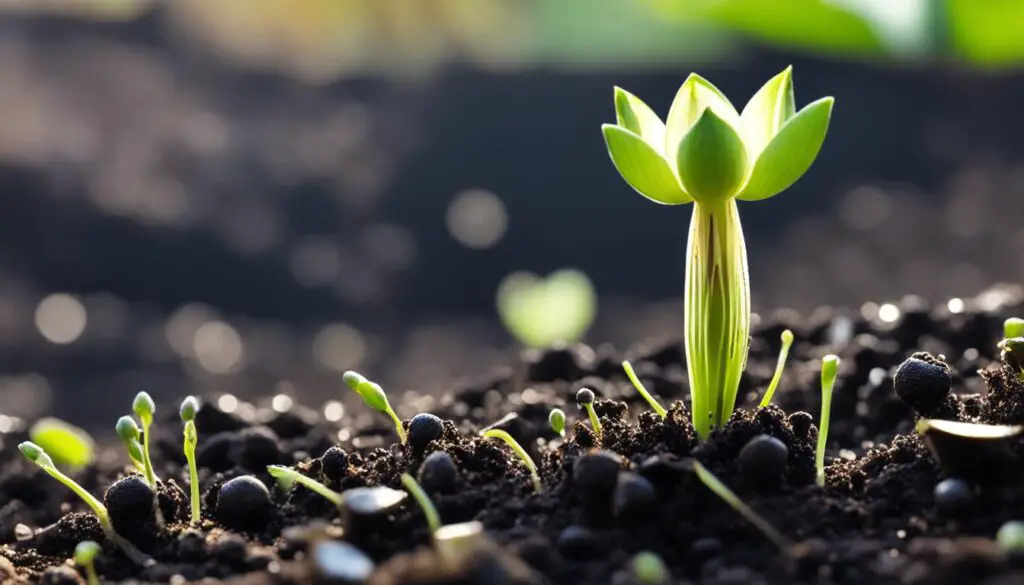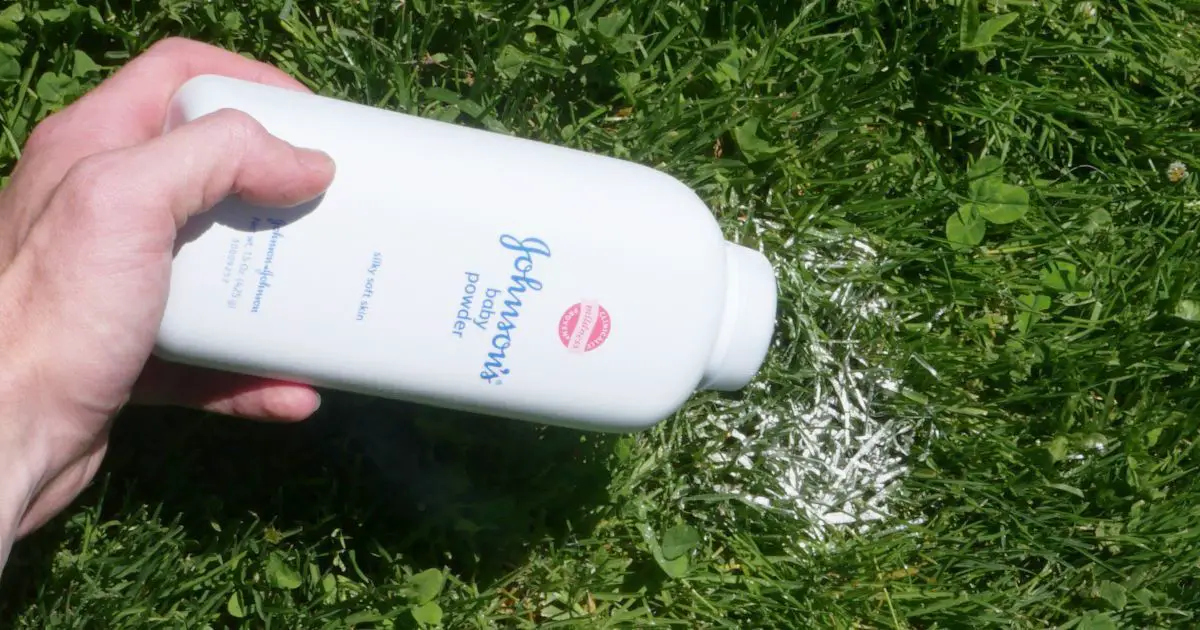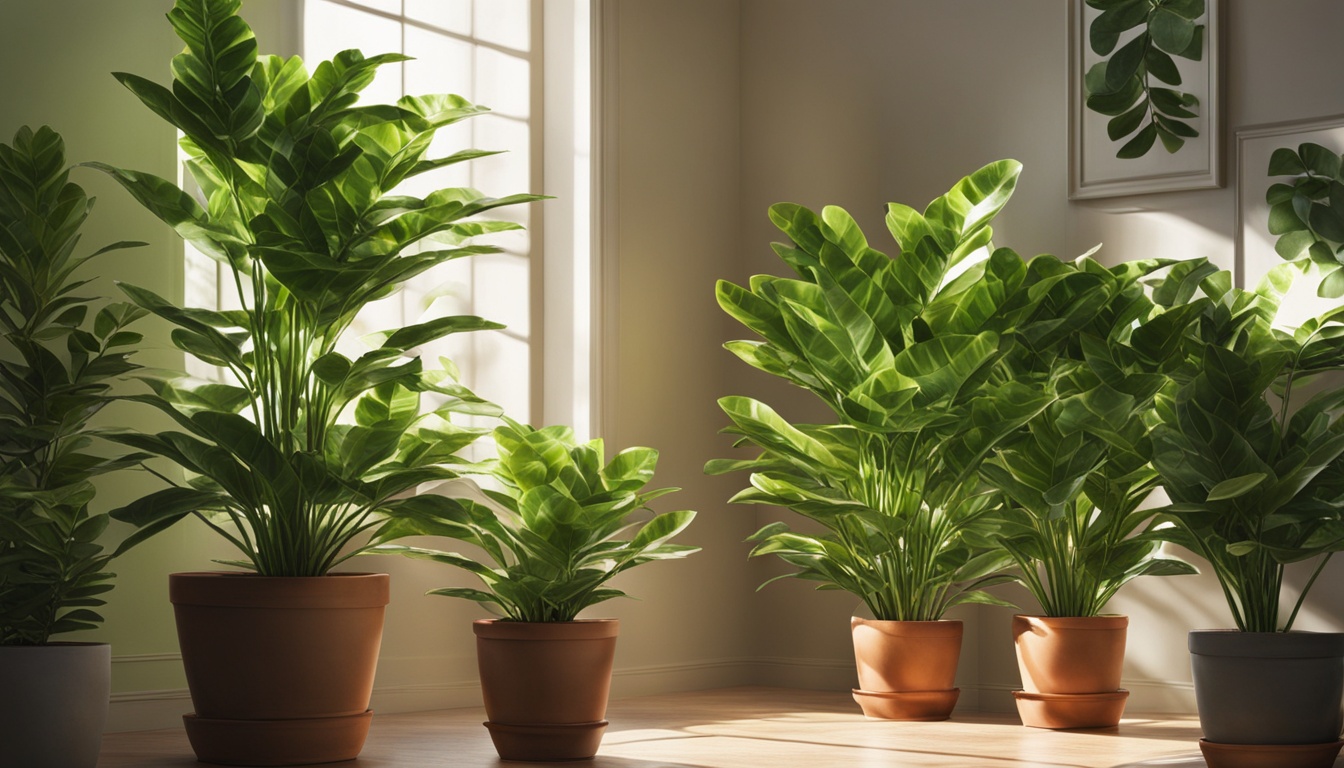I’ve always been drawn to the lotus flower’s beauty and deep meaning. This aquatic plant is known for its large, colorful blooms and unique leaves.
It’s a joy to grow and care for lotus plants, but they need certain conditions to bloom well.
Lotus plants love warm, sunny spots with a minimum temperature of 75°F for three months in summer. They should be in containers that are at least 15-16 inches wide and no taller than 10 inches.
The water level should be 2-4 inches above the soil. Taller varieties can grow in water up to 18 inches deep.

Key Takeaways
- Lotus plants require a minimum temperature of 75°F for at least three months during summer for optimal growth and flowering.
- Lotus plants should be planted in containers with a diameter of at least 15-16 inches and a height of no more than 10 inches.
- Maintain a water level of 2-4 inches above the soil, and the plants can grow in water up to 18 inches deep.
- Lotus plants need full sun or at least six hours of direct light per day to thrive.
- Proper fertilization and care are essential for the long-term health and blooming of lotus plants.
Understanding the Lotus Plant
The lotus plant, known as Nelumbo, is a fascinating aquatic species. It has captured the hearts of people worldwide.
There are two main types: the tropical Nelumbo nucifera and the temperate Nelumbo lutea. Each type has its own special traits, making the lotus diverse and adaptable.
Types of Lotus
Nelumbo nucifera, the tropical lotus, comes from Asia and loves warm, tropical places. It needs temperatures over 75°F for at least three months in summer to grow well. On the other hand, Nelumbo lutea, the temperate lotus, grows in North America and can handle cooler weather.
There are many cultivars and varieties of lotus, meeting the needs of different gardeners. You can find everything from tall, majestic lotus plants to smaller, dwarf ones. This variety makes the lotus perfect for any gardener.
Lotus flowers are known for their beautiful colors like white, pink, red, and blue. Their leaves can be round or elongated, adding to their charm. This variety ensures there’s a lotus for every gardener’s taste and garden conditions.
If you’re drawn to the tropical Nelumbo nucifera or the hardy Nelumbo lutea, growing a lotus plant is rewarding. By learning about these unique species, you can make your garden or water feature stunning.
Growing Lotus from Seeds
Growing lotus plants from seeds is a rewarding journey. It lets you see the life cycle of these aquatic wonders. First, you need to prepare the lotus seeds for germination.
The hard outer shell of lotus seeds must be filed or cut. This lets water get in and start the sprouting process. Amazingly, scientists have sprouted lotus seeds that were over 1,000 years old. This shows how resilient these ancient plants are.
- Put the prepared lotus seeds in warm water and place them in a sunny spot. With the right conditions, the seeds will sprout within a week.
- Once the seedlings emerge, move them to a shallow bowl or container filled with water. Make sure the water is at least 6 inches deep.
- As the young plants grow, slowly increase the water depth to match their expanding roots. Lotus plants do well in water temperatures between 75-87°F. They need at least 6 hours of direct sunlight each day.
To help your lotus grow well, think about using a 10-14-8 aquatic fertilizer. Remember, the plants might go dormant or have yellow leaves as they focus on thickening their tubers. Be patient, as lotus plants usually bloom in their second year.
If you’re gardening in the mid-northern United States or the warm Southern climates, you can grow these beautiful aquatic plants from seed. With the right preparation and care, you’ll be successful.
Lotus Seed Cultivation Tips
- Avoid containers with sharp corners to protect the lotus’ growing tip
- Keep water temperatures in the upper 60s-70s Fahrenheit for the best growth
- Hand-pollinate the flowers to help them produce seeds
- Give them at least 6-7 hours of full sun for the best blooms
| Lotus Seed Preparation | Lotus Seed Germination | Lotus Seed Planting |
|---|---|---|
| File or cut the hard outer shell to allow water penetration | Soak the prepared seeds in warm water and place in a sunny spot | Transplant the sprouted seedlings into a shallow bowl or container |

“Lotus seeds are remarkable in their ability to withstand the test of time, with some scientists successfully sprouting seeds that were over 1,000 years old.”
Grow A Lotus and Care
Potting and Planting
Growing a lotus plant needs careful attention. It has unique needs for potting and planting. These must be met for it to thrive.
The lotus needs a deep pot or container for its roots and tall growth. Use a pot at least 12 inches deep. The pot should be wide enough for the plant to spread out.
Lotus plants prefer clay-based soil over standard potting mix. This type of soil gives the necessary nutrients and support for its roots. Plant the lotus seeds about 4 inches apart in the soil.
The water depth is key for the lotus. Most lotus varieties need 6 to 12 inches of water. The container should be submerged at the right water temperature, between 75 to 87 degrees Fahrenheit.
If you’re putting the lotus in a pond or water garden, choose a sunny spot with still water. The water should be at least 70 degrees Fahrenheit before moving the lotus there.
By following these guidelines for lotus potting, lotus planting, lotus container size, lotus soil, and lotus water depth, you can create the perfect environment. Your lotus will flourish and become the stunning centerpiece of your water garden.
Maintenance and Overwintering
As a lotus enthusiast, I’ve learned that maintaining and overwintering these plants is key. During the growing season, I fertilize my lotus to help them grow well. When it gets colder and days are shorter, I prepare my lotus for winter.
Protecting the lotus tubers from freezing is crucial. If ponds freeze over, I keep my hardy lotus in a spot that stays warm. Or, I leave the pots in deep water for insulation. As they sleep, I prune dead leaves and flowers to keep things neat and promote new growth in spring.
Every few years, I harvest my lotus pots to avoid overcrowding. This lets me split the tubers, get rid of any bad parts, and replant the healthy ones. Storing the tubers in a sealed plastic bag in the fridge keeps them fresh until spring.
FAQ
What makes the lotus flower so popular and symbolic?
The lotus flower is highly valued in many cultures, especially in Asia. Its beauty and ability to grow in murky waters symbolize enlightenment and spiritual awakening. It’s used in religious ceremonies and appears in art and architecture.
What are the key requirements for successfully growing lotus plants?
Lotus plants need full sun, warm water, and specific soil and pot conditions. They should be planted in clay-based soil in containers or ponds with 6-12 inches of water. Preparing the lotus seeds correctly is also key for growth.
What are the two main species of lotus, and how do they differ?
There are two main lotus species: Nelumbo nucifera and Nelumbo lutea. Nelumbo nucifera, from Asia, likes warmer water and grows bigger. Nelumbo lutea, from North America, is more cold-hardy but smaller.
How do I grow lotus plants from seed?
Start by preparing the seeds by filing or cutting the hard shell for germination. Then, sprout the seeds in warm water. Move the sprouts to a shallow bowl or container. Once they’re established, move them to their final spot.
What are the ideal container sizes and soil requirements for growing mature lotus plants?
Mature lotus plants need big containers or ponds for their roots and tall growth. Use clay-based soil mix, not regular potting mix. Keep the water 6-24 inches deep, depending on the lotus type.
How do I care for and maintain my lotus plants throughout the growing season and during the winter?
Feed your lotus plants regularly during the growing season. Prune leaves and flowers as needed. Protect the tubers from freezing in winter. You can overwinter them in deeper water or a greenhouse.



